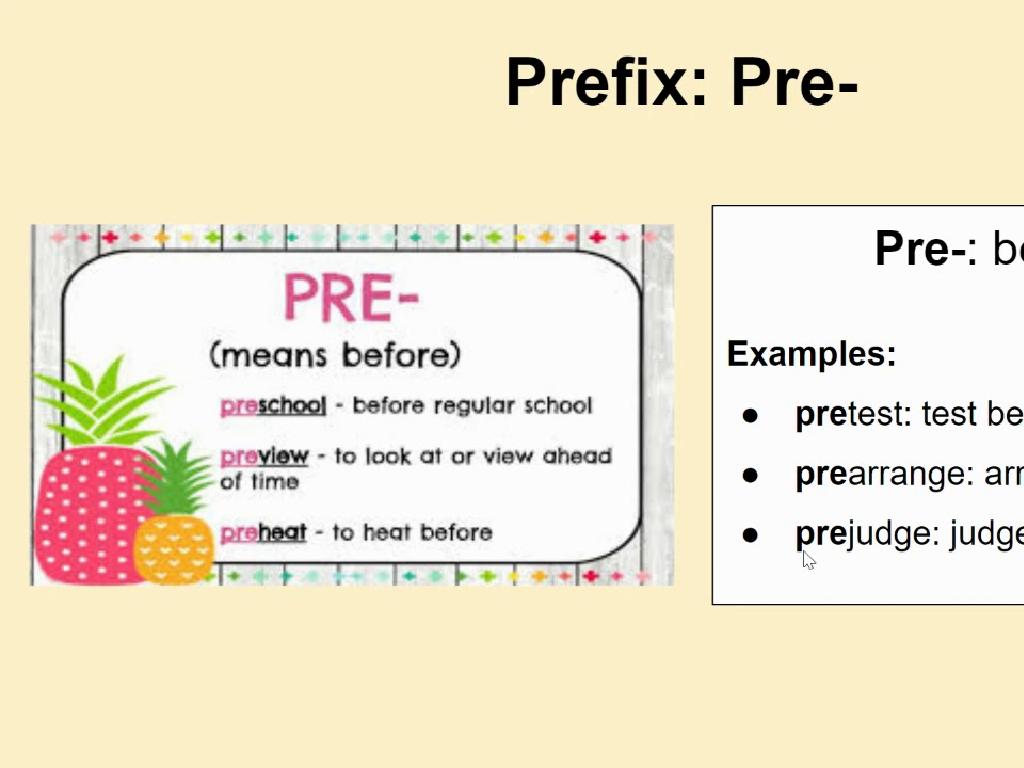Interpret Charts And Graphs To Find Mean, Median, Mode, And Range
Subject: Math
Grade: Seventh grade
Topic: Statistics
Please LOG IN to download the presentation. Access is available to registered users only.
View More Content
Welcome to Statistics: Understanding Data
– Grasp the basics of statistics
– Statistics involves collecting, analyzing, interpreting, and presenting data.
– Real-life importance of statistics
– Used in daily decisions, sports, health, and more.
– Today’s focus: Mean, Median, Mode, Range
– Mean: average, Median: middle value, Mode: most frequent, Range: difference between highest and lowest.
– Applying these concepts
|
Begin the lesson by introducing the field of statistics as a powerful tool for understanding and interpreting data. Emphasize its relevance in various aspects of everyday life, such as making informed decisions, understanding sports statistics, or analyzing health information. Today’s lesson will focus on the four key concepts of descriptive statistics: mean, median, mode, and range. Explain each concept with examples and show how they can be derived from a given set of data. Engage students with real-world scenarios where these statistical measures are applied. Encourage participation by asking students to think of situations where they might use these measures in their lives.
Understanding Mean in Statistics
– Mean: The Average Value
– Mean, or average, is the sum of values divided by the number of values.
– Calculating Mean: Total divided by Count
– Add up all the numbers in a set, then divide by how many numbers there are.
– Example: Mean of a Number Set
– For the set 3, 5, 7, 10, calculate: (3+5+7+10)/4.
|
The mean, commonly known as the average, is a fundamental statistical measure that represents the central value of a data set. To calculate the mean, students should sum all the numbers in a given set and then divide by the total count of numbers. For example, to find the mean of the set 3, 5, 7, and 10, students add these numbers to get a total of 25, then divide by 4, since there are 4 numbers in the set, resulting in a mean of 6.25. It’s important for students to practice this with different sets of numbers to become comfortable with the process.
Finding the Median in Data Sets
– Median: The middle value
– Median is the middle number in an ordered list
– Steps to find the median
– 1. Arrange numbers 2. Find the middle value
– Example with odd number set
– Odd set: 3, 5, 7 (Median is 5)
– Example with even number set
– Even set: 2, 4, 6, 8 (Median is between 4 and 6)
|
The median is a measure of central tendency that represents the middle value in a data set when the numbers are arranged in order. To find the median, students should first arrange the numbers in ascending or descending order. If there is an odd number of values, the median is the middle one. If there is an even number of values, the median is the average of the two middle numbers. Provide examples with both odd and even sets of numbers to illustrate the process. Encourage students to practice with additional data sets and to understand how the median can provide insight into the distribution of a data set.
Understanding Mode in Statistics
– Define mode in statistics
– Mode: The value that appears most frequently in a data set.
– Steps to identify the mode
– List the numbers, count how often each number occurs, the one with the highest frequency is the mode.
– Example: Finding the mode
– Given dataset: 12, 15, 12, 18, 12, 20, 22. Mode is 12, as it appears most often.
|
The mode is a basic statistical measure that represents the most common value in a dataset. It’s particularly useful in understanding the frequency of occurrence of certain values. When teaching students how to find the mode, emphasize the importance of organizing the data set and counting the frequency of each number. The example provided should be worked through as a class, with students identifying the mode of the dataset. This will help them grasp the concept of mode as a measure of frequency and how it can be applied to real-world data.
Calculating the Range in Statistics
– Define the range
– Range: difference between highest & lowest values in a set
– Steps to find range
– 1. Identify max & min numbers 2. Subtract min from max
– Example: Dataset range
– Given data: 4, 8, 15, 16, 23, 42. Range = 42 – 4 = 38
– Practice with your data
|
The range is a measure of how spread out numbers in a dataset are. To calculate the range, students should first identify the maximum and minimum numbers in the dataset. Then, they subtract the smallest number from the largest to find the range. For example, with the dataset 4, 8, 15, 16, 23, 42, the range is 42 minus 4, which equals 38. This indicates how much the numbers in the set vary. Encourage students to practice by finding the range of different datasets to solidify their understanding.
Interpreting Graphs: Key Statistics
– Reading various graph types
– Learn to interpret bar, line, and pie charts
– Find Mean, Median, Mode, Range
– Mean: average, Median: middle, Mode: frequent, Range: difference
– Practice with a given graph
– Use a sample graph to calculate statistics
– Understand real-world applications
|
This slide introduces students to the skills needed to interpret different types of graphs and extract key statistical measures. Start by explaining how to read bar graphs, line graphs, and pie charts, focusing on the axes and what they represent. Then, define mean, median, mode, and range, providing examples of each from the context of a graph. For the practice activity, provide a graph and walk students through the process of finding each measure. Emphasize how these statistics can be used to summarize data in real-world scenarios, such as analyzing class test scores or sports team performance. Encourage students to practice these skills with various graphs to build their confidence.
Let’s Practice Together!: Interpreting Graphs
– Group activity: Analyze different graphs
– Each group gets a unique graph
– Calculate Mean, Median, Mode, Range
– Mean: Add all numbers, divide by count; Median: Middle value; Mode: Most frequent; Range: Difference between highest and lowest
– Collaborate and discuss findings
|
This class activity is designed to reinforce the concepts of mean, median, mode, and range through group work. Divide the class into small groups and provide each group with a different graph. The graphs could be bar graphs, line graphs, or pie charts with various data sets. Each group’s task is to analyze their graph and calculate the mean, median, mode, and range of the data presented. Encourage students to work together, discussing their methods and findings. Possible activities: 1) Comparing results between groups, 2) Discussing why different graphs may yield different types of averages, 3) Exploring how outliers affect the mean and median, 4) Creating a poster with their graph and calculations to present to the class.
Review and Q&A: Understanding Data
– Recap: Mean, Median, Mode, Range
– Mean: average, Median: middle value, Mode: most frequent, Range: difference between highest and lowest
– Encourage questions from students
– Discuss activity challenges
– Share experiences and hurdles encountered
– Strategies for overcoming difficulties
– Tips: recheck calculations, understand each step
|
This slide aims to consolidate the students’ understanding of statistical concepts and provide a platform for addressing any uncertainties. Begin with a brief recap of the mean, median, mode, and range, ensuring students can differentiate between them. Open the floor for questions, encouraging students to voice any confusion they may have. Discuss any common difficulties that were observed during the class activity, and offer strategies to overcome these challenges, such as double-checking work and breaking down each problem into smaller, manageable steps. This interactive session will help reinforce the material and promote a collaborative learning environment.
Homework: Mastering Statistics with Practice
– Complete the worksheet on charts and graphs
– Practice calculating mean, median, mode, and range
– Find the average, middle value, most frequent, and data spread
– Introduction to Probability in the next class
– Use the worksheet to prepare
– Understanding these concepts will help grasp probability
|
This homework assignment is designed to reinforce students’ understanding of statistical measures through practical application. The worksheet provided will contain various charts and graphs from which students will need to extract data and calculate the mean, median, mode, and range. These exercises will solidify their comprehension of how to interpret data sets. Additionally, this practice will serve as a foundation for the upcoming lesson on probability, as a good grasp of statistics is crucial for understanding probability concepts. Encourage students to attempt all questions and remind them that these skills are not only key in math but also in real-world data analysis.





